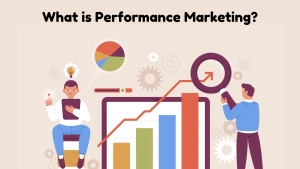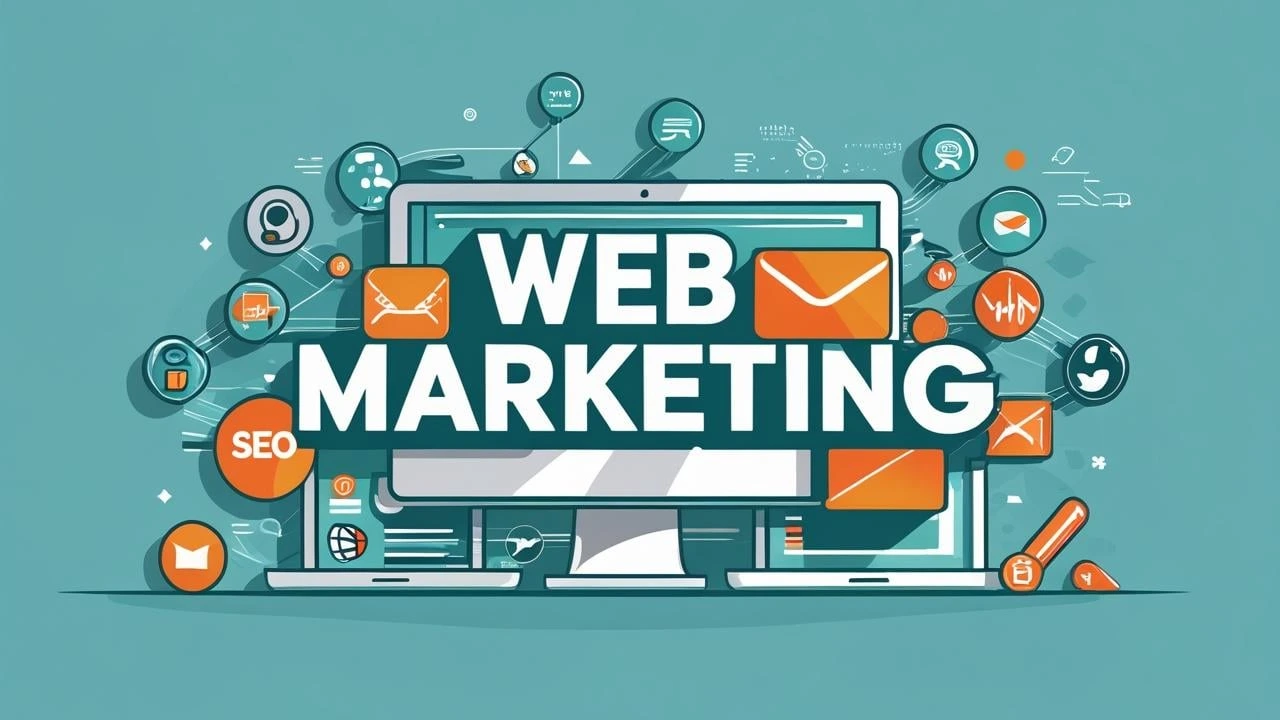Table of Contents
Introduction
In today’s fast-paced digital landscape, businesses are continuously looking for ways to enhance their online presence and drive growth. Despite their frequent interchangeability, these terms are not interchangeable. Understanding the difference is crucial for businesses to optimize their marketing strategies and achieve specific goals.
Let’s delve into the nuances of performance marketing vs digital marketing, their methodologies, advantages, and how they can be utilized effectively to meet your business objectives.
What is Digital Marketing?

Digital marketing encompasses all marketing activities conducted online to promote products, services, or brands. This broad field uses various digital channels like search engines, social media platforms, websites, email, and more to reach and engage a target audience.
Key Components of Digital Marketing
- Pay-Per-Click Advertising (PPC): Paid ads displayed on search engines or social media platforms.
- Content Marketing: The technique of creating educational content, like blogs, films, and infographics, in order to attract visitors is known as information marketing.
- Email Marketing: Sending personalized emails to nurture leads and boost customer loyalty.
- Social Media Marketing: Leveraging platforms like Facebook, Instagram, LinkedIn, and Twitter to build brand awareness and engagement.
- Search Engine optimization (SEO)
Goals of Digital Marketing
The primary goal is to create a consistent online presence, build brand awareness, and establish trust with the audience. Metrics like website traffic, social media followers, and email open rates are often used to measure success.
What is Performance Marketing?

A type of digital marketing that emphasizes quantifiable outcomes is called performance marketing. Companies only make payments when a certain action—like clicks, leads, or sales—is accomplished. It all boils down to maximizing campaigns for a high return on investment and producing quantifiable results.
Key Components of Performance Marketing
- Affiliate Marketing: Collaborating with affiliates who receive a commission for generating traffic or purchases is known as affiliate marketing.
- Influencer Marketing: Collaborating with influencers to promote products or services on a pay-for-performance basis.
- Native Advertising:Using advertisements that naturally integrate in with the platform’s content is known as “native advertising.”
- Retargeting Ads:Retargeting advertisements are used to re-engage customers who have already interacted with your brand but haven’t made a purchase.
Goals of Performance Marketing
The primary focus is on tangible results such as customer acquisition, lead generation, or direct sales. Performance metrics like cost-per-click (CPC), cost-per-lead (CPL), and return on ad spend (ROAS) are critical indicators of success.
When to Use Digital Marketing?
- Digital marketing is ideal when you want to:
- Build long-term brand awareness.
- Reach a broad audience through diverse channels.
- Nurture leads and build relationships.
- Educate your audience with valuable content.
For instance, a newly launched tech company might use digital marketing strategies like blogging and SEO to build its online presence and establish authority in the industry.
When to Use Performance Marketing?
- Performance marketing works best when:
- Your primary goal is to drive conversions.
- You have a specific budget tied to outcomes.
- You want to minimize risks with measurable campaigns.
- Scaling paid campaigns based on ROI is a priority.
For example, an e-commerce store looking to boost sales during a holiday season might focus on performance marketing campaigns to target high-intent buyers.
Blending Performance Marketing and Digital Marketing
Rather than choosing one over the other, many businesses benefit from combining both strategies. This hybrid approach ensures that you’re building a strong brand while also driving measurable results.
Why Digital Marketing is Vital for Long-Term Success

In the difference between performance marketing vs digital marketing, digital marketing allows businesses to establish their identity, foster trust with their audience, and lay the groundwork for future growth. Let’s explore some additional facets that make digital marketing indispensable.
Building a Strong Brand Presence
Businesses can create a distinctive and consistent identity with the use of digital marketing. For instance, companies like Apple and Nike don’t rely solely on performance-driven campaigns. Instead, their branding, storytelling, and long-term strategies contribute to their global appeal.
Key steps for strong brand-building include:
- Designing a memorable logo and visual identity.
- Consistently posting high-quality content.
- Engaging with customers through social media.
- Sharing success stories, testimonials, and case studies.
Driving Customer Engagement
Interactive content like polls, quizzes, live streams, and user-generated content helps keep customers engaged. Digital marketing platforms allow you to interact with your audience directly, fostering relationships that lead to loyalty.
Example: A cosmetics brand might use Instagram Stories to run polls about upcoming product launches, generating excitement and gathering valuable customer feedback.
Developing Evergreen Campaigns
In the difference between performance marketing vs digital marketing, Unlike performance marketing, which is often campaign-specific, digital marketing efforts like blog posts, videos, or white papers can deliver value for years. For instance, an SEO-optimized blog post answering a common industry question can attract consistent organic traffic over time.
Performance Marketing: The Game-Changer for Immediate Results

In the comparison between performance marketing vs digital marketing, While digital marketing builds the foundation, performance marketing excels in driving immediate actions. Let’s investigate how to best utilize this strategy.
Performance Marketing Channels That Deliver Results:
Google Ads:
Google Ads allow businesses to target high-intent users searching for specific products or services.
For instance, a nearby bakery can use Google Ads to show up when people look for “best cupcakes near me.”
Social Media Advertising:
Platforms like Facebook, Instagram, and TikTok are excellent for reaching specific demographics.
Example: A fitness apparel brand can use Facebook ads targeting young adults interested in gym equipment.
Affiliate Marketing:
Affiliate marketers act as an extended salesforce, promoting products to their audience for a commission.
Example: An e-commerce store might partner with influencers to generate sales through affiliate links.
Advanced Tips for Combining Performance and Digital Marketing

Retargeting with a Twist
Use performance marketing retargeting campaigns to complement digital marketing efforts. For instance, if someone visits your website after discovering a blog post, retarget them with an offer for a related product.
Pro Tip: Use tools like Facebook Pixel or Google Analytics to track user behavior and segment audiences for better targeting.
A/B Testing for Better Campaigns
Both digital and performance marketing strategies benefit from A/B testing. Experiment with different headlines, CTAs, and ad visuals to determine what resonates best with your audience.
Example: Test two variations of a landing page—one emphasizing storytelling (digital marketing approach) and the other with a direct sales offer (performance marketing approach).
Cross-Channel Promotion
Promote your performance marketing campaigns using digital marketing channels. For example, announce limited-time offers (performance marketing) through your email list or social media profiles (digital marketing).
Real-World Case Studies
Case Study 1: A SaaS Company’s Success
A SaaS company wanted to boost free trial signups for its project management software. In the difference between performance marketing vs digital marketing, Here’s how it used a blend of digital and performance marketing:
- Digital Marketing: Created blog content around “Top Tools for Remote Teams,” which ranked on Google and drove traffic to their website.
- Performance Marketing: Retargeted blog readers with Facebook ads offering a free trial.
Result: The combination strategy resulted in a 35% increase in free trial signups over three months.
Case Study 2: An E-commerce Brand’s Holiday Campaign
In the distinguish between performance marketing vs digital marketing, An online fashion retailer aimed to maximize sales during Black Friday:
- Digital Marketing: Built anticipation with email newsletters and Instagram posts showcasing upcoming deals.
- Performance Marketing: Ran PPC campaigns and influencer collaborations with discount codes.
Result: A 50% increase in sales compared to the previous year, with significant growth in new customer acquisition.
Emerging Trends in Performance Marketing and Digital Marketing

AI and Automation
AI tools like Google Performance Max and Facebook’s Advantage+ campaigns are revolutionizing performance marketing by automating audience targeting and bid strategies. Similarly, AI is being used in digital marketing for chatbots, content recommendations, and predictive analytics.
Personalization at Scale
Both strategies are shifting towards hyper-personalized experiences. In digital marketing, this means curating content tailored to individual preferences. For performance marketing, it involves showing ads that resonate with users’ specific needs and behaviors.
Interactive Content
Interactive elements, such as polls, quizzes, and shoppable videos, are becoming staples of digital marketing. Performance marketers are also leveraging these tools to engage audiences and drive conversions
Challenges to Overcome

Digital Marketing Challenges:
- Keeping up with constantly changing algorithms.
- Generating consistent content that resonates with diverse audiences.
- Measuring ROI, especially for top-of-funnel activities like content marketing.
Performance Marketing Challenges:
- Seeing the same advertisements over and over again might cause ad fatigue.
- Rising costs for paid campaigns, especially on competitive platforms.
- Attribution issues in multi-touchpoint customer journeys.
Future of Performance and Digital Marketing
The distinction between performance marketing and digital marketing is expected to blur further as technology advances. Businesses will increasingly integrate both approaches to achieve holistic success.
What to Expect in the Future:
- Greater emphasis on omnichannel marketing, where customers experience a seamless journey across platforms.
- Enhanced tools for attribution modeling to measure performance more accurately.
- Continued growth in video marketing for both brand awareness and conversions.
How to Combine Them Effectively
- Use digital marketing to build trust and establish authority with content, SEO, and social media.
- Leverage performance marketing to capitalize on immediate opportunities like PPC campaigns or affiliate programs.
- Continuously track and optimize campaigns to ensure you’re meeting both long-term and short-term goals.
Advantages of Performance Marketing and Digital Marketing
In the difference between performance marketing vs digital marketing, there are some Advantages between them they are:
Advantages of Digital Marketing
- Wider Reach: Access to global audiences across multiple platforms.
- Cost-Effective: Organic strategies like SEO and content marketing have long-term benefits.
- Brand Building: Helps establish trust and loyalty.
- Versatility: Fits companies of all sizes and sectors.
Advantages of Performance Marketing
- Measurable ROI: Clear insights into what’s working.
- Low Risk: Pay only for successful actions.
- Flexibility: Campaigns can be scaled or paused instantly.
- Targeted Approach: Focus on high-intent audiences.
Conclusion
Choosing between performance marketing vs digital marketing isn’t about picking one over the other—it’s about understanding your business goals and leveraging both approaches to achieve success. While digital marketing lays the foundation for your online presence, performance marketing ensures that your campaigns deliver measurable results.
In the difference between performance marketing vs digital marketing, combining the strengths of both strategies, businesses can build a powerful, comprehensive marketing approach that drives both immediate and long-term growth. Understanding the strengths and limitations of each, businesses can create an integrated strategy that maximizes ROI while building lasting relationships with their audience.
Author : Mashhar Mohamed
Learner of Digiskillz, Digital marketing course in Kottakkal











Leave A Comment